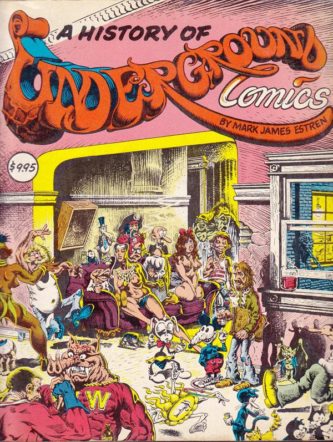 By MARK JAMES ESTREN (Straight Arrow Books; 1974)
By MARK JAMES ESTREN (Straight Arrow Books; 1974)
The first and very likely best history of underground “comix” in America. Such fare emerged from the 1960s counterculture in the form of publications like ZAP and BIJOU FUNNIES, created by artists like R. Crumb, S. Clay Wilson, Spain and others who reveled in imagery and attitudes that definitely weren’t in synch with the values of mainstream America (with the dictates of the Comics Code Authority of America, strictly enforced in most “aboveground” comics, completely ignored). Another key feature of those comics was the brilliance and sophistication of the artwork, which often belied the crudity of the stories (and is now considered Fine Art).
…the brilliance and sophistication of the artwork, which often belied the crudity of the stories (and is now considered Fine Art).
Author Mark James Estren provides a wide-ranging account of the underground comic scene, its influences and the controversies it engendered. Estren is evidently a smart dude, being (as we’re reminded on more than one occasion in these pages) a cum laude graduate of Wesleyan University and a Pulitzer Fellowship winner. Not that this history is entirely essential, as Estren concedes in his introduction that “The best way to learn about underground comics is simply to read them and let them tell their own story.” To this end Estren packs every page with examples of underground comic art that often far out-space the text.
That text traces the history of underground comic books, starting in the early Twentieth Century, when artists like Richard Outcault and Gustave Verbeek provided an early template for likes of Crumb, Wilson et al. Further influences included the X-rated EIGHT-PAGERS (or TIJUANA BIBLES) comic strips that appeared in the 1930s and the E.C. comics of the 1940s and 50s, particularly the horror-themed ones (an entire story from which is included here as an appendix) and the early Harvey Kurtzman edited issues of MAD. The next big development was the inception of the San Francisco based ZAP COMIX by the irrepressible R. Crumb, and the movement was off and running with titles like YELLOW DOG COMIX, FEDS N’ HEADS, DEATH RATTLE, INSECT FEAR, SKULL and DEVIANT SLICE FUNNIES.
…traces the history of underground comic books, starting in the early Twentieth Century, when artists like Richard Outcault and Gustave Verbeek provided an early template for likes of Crumb, Wilson et al.
Included are profiles of all the major comix figures, and extensive interviews with the likes of Kurtzman, John Thompson, Robert Williams, Jaxon, Skip Williamson and others. All, we discover, are quite knowledgeable and articulate about what they do (Williamson: “The comics appeal to crude, base emotions—they’re basically anti-intellectual on a good ol’ American level”), and that many, such as Greg Irons, George Metzger and Kim Deitch, were professional artists before dabbling in the underground comics world.
To his credit, Estren confronts some of the thornier issues surrounding underground comix, such as the sexism employed by its cadre of nearly all-male practitioners. It’s not lost on Estren that these guys profess to be anti-puritanical revolutionaries yet share some mighty outdated attitudes about women, apparently the “one area in which the underground comics have been largely unable to break from the society in which they were created.”
To his credit, Estren confronts some of the thornier issues surrounding underground comix, such as the sexism employed by its cadre of nearly all-male practitioners.
If I have an overriding criticism it’s that, simply, this book was written and published too soon to provide a truly definitive look at the underground comix scene, with important figures like Harvey Pekar and Gilbert Hernandez going unmentioned (correction: Pekar does get a brief mention, but only as a “personal friend” of R. Crumb) due to the fact that they made their mark after 1974 (for the record, the book was republished in 1987 and ‘93, but from what I understand no substantial additions were made). A HISTORY OF UNDERGROUND COMICS, then, functions best as a historical overview of the early days of the movement, and as such it really can’t be faulted.
